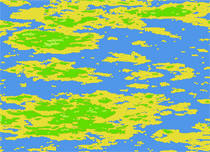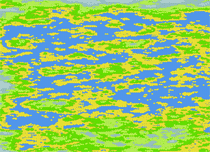Random Pixel Tile Map Generator
I found something to do that connects the things that interest me most at the moment: automatically generated game content, number juggling in Matlab, browser games and pixel art. I’m not much of an artist so all I can do regarding pixel art is being astonished about the marvelous things pixel artists are able to do. However being a programmer I thought of a way to circumvent the art part and still create something cool. So the idea is to let the computer create the art by means of a random number generation and some number juggling.
 I wrote a script that creates a pixel tile based map from a random height map and created 6 pixel tiles for the different heights. I wanted water, a beach, nice grasslands and icy mountains. To generate the height map I used Matlab. I tried a couple of different techniques and finally ended up using a perlin noise algorithm.
I wrote a script that creates a pixel tile based map from a random height map and created 6 pixel tiles for the different heights. I wanted water, a beach, nice grasslands and icy mountains. To generate the height map I used Matlab. I tried a couple of different techniques and finally ended up using a perlin noise algorithm.
I also experimented with a simple Gaussian distribution random number generator and tried to fit the numbers to my needs. However it turned out to be ‘too’ noisy as I was aiming for continents and large mountain ranges. The Gaussian distribution however gave me only small islands. I tried to smooth it with different filters which made it a little better but I realized the numbers where fundamentally different from what I wanted.
The image on the left is created with Gaussian distribution, the second has a 7×7 Gaussian blur filter applied 3 times and the third one is created with Perlin noise. Go ahead and click on the images to view the full size version. They are quite large so they might take a second to load. I got the matlab code for the Perlin noise generator from Christopher Wellons’ blog post about Noise Fractals and Clouds. He wrote it for GNU Octave, a tool which I have to try out yet. To use it in Matlab only a slight modification was necessary:
function s = perlin (m)
s = zeros(m); % output image
w = m; % width of current layer
i = 0; % iterations
while w > 3
i = i + 1;
d = interp2(randn(w), i-1, 'spline');
s = s + i * d(1:m, 1:m);
w = w - ceil(w/2 - 1);
end
end
Now this looks quite inconspicuous but there’s quite something to those 11 lines of code. The interp2() function recursively expands the matrix returned by rand(w) i-1 times with spline interpolation. This contains the frequency of the the function and the i in the following line represents the amplitude. Quite elegant really! The only thing to criticize about this code is probably that it can’t exploit the fact that Perlin noise can create continuous noise resulting in an infinite world. To do that I guess you need a seeded random number generator. Matlab let’s you save and restore the state of the generator with:
s = randn('state'); %save state to s
randn('state',s); %restore state from s
which might enable you to accomplish just that. And finally here’s a PHP script that let’s you generate a map based on a height map in a CSV File (sample file). Be warned though: PHP is a very bad choice to do these kinds of things and the script is therefore very slow. A ZIP file containing the PHP script, the test data and the 6 separate pixel tiles can be downloaded from here.
1 Comment
Sorry, the comment form is closed at this time.



Your Perlin based map looks really interesting. Just looking at the image makes me wish there was a game behind it!
Also, I’m glad someone else made use of my code. ;-)